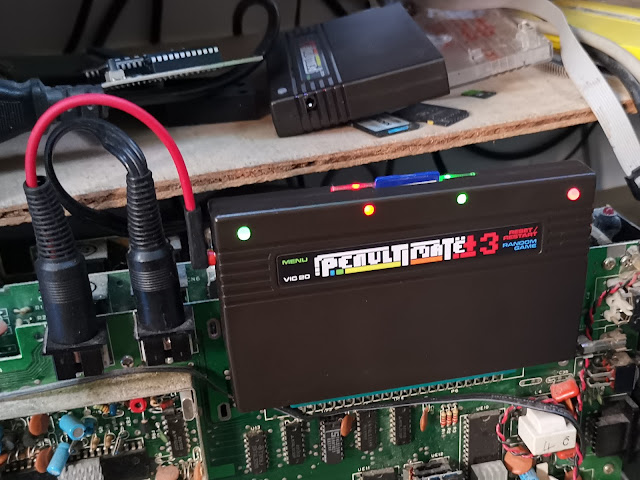When I am testing a Minstrel 2 or 3, or the new Minstrel 4th ZX80 and ZX81 modes, I try to load from various sources.
Sometimes ZXpand, sometimes a tzxduino based player, sometimes tape, sometimes vintage tapes.
When testing the Minstrel 4th ZX81 mode, I tried various of my original 1980s tapes as well as ones I have picked up since.
It's good to see a game loading from tape like that, the same tape I used to load the game 40+ years ago.
I used to quite like "Perilous Swamp". I managed to rescue the princess.
But was beaten at the last step. (this is all written in BASIC, and I remember I spent a lot of time in my youth looking through games like this to see how they worked and making my own versions. Must resist looking to see what the algorithm for "fight" is, presumably relative strength plus some random element?)
One tape I can't load like that is unfortunately 3D Monster Maze.
I do have _a_ 3D Monster Maze tape, but it's not _my_ 3D Monster Maze tape, that is in a safe place.
Somewhere.
The problem is that one does not load. It always seems to fail at the same point, it fails to load one way or another on a ZX81. It is easier to see that with the load countdown on the Minstrel 4th.
When I modified ZX81 BASIC for the Minstrel 4th, I ended up writing a whole new LOAD routine, which seem to perform better than the original one with some tapes, but not in this case.
I tried sampling the waveform, and you can see it dips to almost nothing at one point.
I wondered if I could re-record it.
It felt wrong, but I guess that tape is never going to load as it was.
Those who did not grow up with tapes may not recognise the significance of the tape, there are holes in to the of the case that stop it being recorded on. Add tape and then you can. Normally sellotape would be used, I have used brown parcel tape to make it more obvious.
It is an old tape, so I blanked it several times first to make sure it was a good starting point.
OK, no going back now.
I used my "master tape creator", which is a Spectrum +2 with a tzxduino "temporarily" installed in it (since 2017).
Time to write the tape.
I played it back, but unfortunately, it also dipped in the same place.
OK, plan B. Next level of wrongness.
I decided to replace the tape. The case was unfortunately sealed on both side, no screws, so I had to splice in a new section between the two sections of red leader tape.
I took a "new" C15 tape and recorded 3D Monster Maze onto it.
This one looks like the label was applied by the same person that used to put the labels onto Dragon 32s.
The sampled version also looked a lot more consistent.
I tried loading it, and it loaded fine.
(I had made sure to get the right version with the J.K.Greye copyright, and not the reissue by New Generation Software)
OK, there we go, I cut the tape out of the original 3D Monster Maze tape and then spliced in the new C15 tape.
I used my incredibly expensive professionally calibrated tape winding device....
And wound the new tape carefully into the shell. Once it had all gone it, I cut the end from the C15 spool and spliced it to the other end of the 3DMM tape.
OK, time to give it a go.
Great, it's nice to be able to load 3D Monster Maze from tape again.
I was concentrating on getting the tape to lay flat for the photos and ended up with the splicing tape on the wrong side, I will need to go back and redo that, but it works fine.
Adverts
The Minstrel 2, 3 and 4th is all included in the 15% off everything in my Tindie store for the whole of July.
Be quick, there is not long left to take advantage of that offer.
Patreon
You can support me via Patreon, and get access to advance previews of things going on behind the scenes updates, currently working on the Mini VIC and Mini PET II. This also includes access to my Patreon only Discord server for even more regular updates.




























































